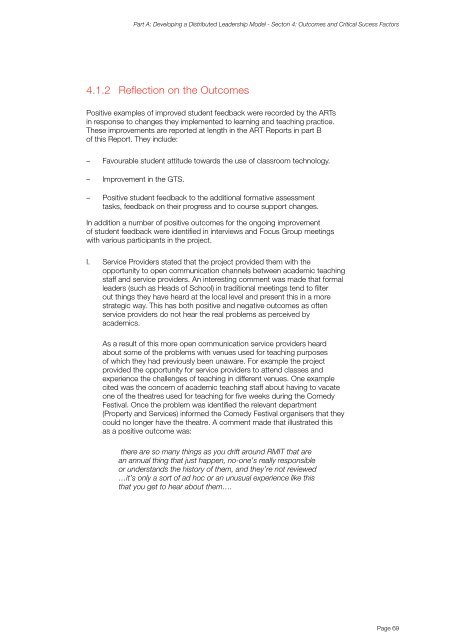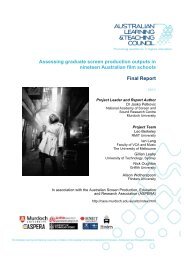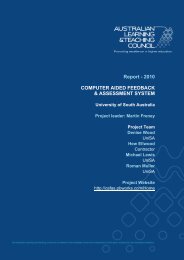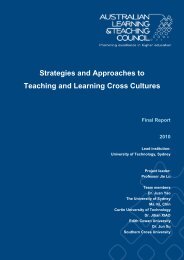student feedback and leadership - Office for Learning and Teaching
student feedback and leadership - Office for Learning and Teaching
student feedback and leadership - Office for Learning and Teaching
You also want an ePaper? Increase the reach of your titles
YUMPU automatically turns print PDFs into web optimized ePapers that Google loves.
Part A: Developing a Distributed Leadership Model - Secton 4: Outcomes <strong>and</strong> Critical Sucess Factors4.1.2 Reflection on the OutcomesPositive examples of improved <strong>student</strong> <strong>feedback</strong> were recorded by the ARTsin response to changes they implemented to learning <strong>and</strong> teaching practice.These improvements are reported at length in the ART Reports in part Bof this Report. They include:––Favourable <strong>student</strong> attitude towards the use of classroom technology.––Improvement in the GTS.––Positive <strong>student</strong> <strong>feedback</strong> to the additional <strong>for</strong>mative assessmenttasks, <strong>feedback</strong> on their progress <strong>and</strong> to course support changes.In addition a number of positive outcomes <strong>for</strong> the ongoing improvementof <strong>student</strong> <strong>feedback</strong> were identified in interviews <strong>and</strong> Focus Group meetingswith various participants in the project.I. Service Providers stated that the project provided them with theopportunity to open communication channels between academic teachingstaff <strong>and</strong> service providers. An interesting comment was made that <strong>for</strong>malleaders (such as Heads of School) in traditional meetings tend to filterout things they have heard at the local level <strong>and</strong> present this in a morestrategic way. This has both positive <strong>and</strong> negative outcomes as oftenservice providers do not hear the real problems as perceived byacademics.As a result of this more open communication service providers heardabout some of the problems with venues used <strong>for</strong> teaching purposesof which they had previously been unaware. For example the projectprovided the opportunity <strong>for</strong> service providers to attend classes <strong>and</strong>experience the challenges of teaching in different venues. One examplecited was the concern of academic teaching staff about having to vacateone of the theatres used <strong>for</strong> teaching <strong>for</strong> five weeks during the ComedyFestival. Once the problem was identified the relevant department(Property <strong>and</strong> Services) in<strong>for</strong>med the Comedy Festival organisers that theycould no longer have the theatre. A comment made that illustrated thisas a positive outcome was:there are so many things as you drift around RMIT that arean annual thing that just happen, no-one’s really responsibleor underst<strong>and</strong>s the history of them, <strong>and</strong> they’re not reviewed…it’s only a sort of ad hoc or an unusual experience like thisthat you get to hear about them….Page 69
















